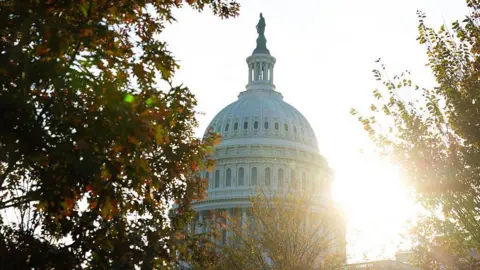With a bipartisan Senate vote to approve funding the federal government now in the books, the longest shutdown in US history appears to be inching towards a resolution.Furloughed federal employees will return to work. They, and those who were deemed too “essential” to send home, will start receiving pay cheques – including back pay – once again.Air travel in the USwill return to a somewhat tolerable normal. Food aid for low-income Americans will resume. National parks will reopen.The ordeals, great and small, that the shutdown had triggered for many Americans will end.The political consequences of this record standoff, however, will linger even as the government returns to work.Here are three major takeaways now that an exit ramp has come into view.
In the end, the Democrats blinked. Or, at least, just enough centrists, soon-to-be retirees and at-risk politicians in the Senate to give Republicans the support needed to reopen the government.For those who voted along with Republicans, the pain fromthe shutdownhad become too severe. For others in the party, however, it was the cost of backing down that was unbearable.”I cannot support a deal that still leaves millions of Americans wondering how they are going to pay for their healthcare or whether they will be able to afford to get sick,” Senator Mark Warner of Virginia said in a statement.The way this shutdown is ending is sure to reopen old wounds between the party’s activist and left-wing base and its institutionalist, centrist establishment. The divides within the party, which last week was celebrating electoral victories in Virginia and New Jersey, are sure to sharpen.Democrats have been outraged over Republican-backed cuts to government programmes and reductions in the federal workforce. They’ve accused Donald Trump of pushing – and breaking – the boundaries of presidential power. They’ve warned that the nation is veering toward authoritarianism.The shutdown, for many on the left, was a chance for Democrats to draw a line in the sand. And now that it appears the government will reopen with no fundamental changes or new limits on Trump, many on the left will feel this was a wasted opportunity. And they will be angry.
在持续40天的政府停摆期间,特朗普两次出访中东与东亚,多次前往私人庄园度假打高尔夫,并在海湖庄园举办了一场盖茨比风格的奢华筹款派对。然而他始终未推动共和党与民主党妥协——这种强硬立场最终奏效。
白宫同意撤回停摆期间实施的”死神式”劳动力削减计划,参议院共和党人承诺就政府医保补贴方案进行表决。但表决不等于保障,且特朗普团队在第40天让步的内容与首日谈判条件并无实质差异。最终打破僵局支持重启政府的民主党参议员坦言,他们对共和党已不抱期望。
“这套策略行不通,”与民主党结盟的无党派议员安格斯·金评价停摆策略。新罕布什尔州民主党议员珍妮·沙欣表示周日达成的协议是”唯一可行方案”,并强调”拖延只会延长停摆给民众带来的痛苦”。
尽管特朗普时而摇摆——曾提议以直接支付取代医保补贴,甚至考虑废除参议院拖延议事程序以削弱民主党权力,但共和党最终团结一致,成功让足够多的民主党人相信他们绝不会让步。
这场创纪录的停摆虽近尾声,但引发僵局的政治动因依然存在。妥协法案仅维持政府运作至一月底,刚够度过假日季。此后国会可能重蹈九月资金耗尽的覆辙。民主党此次虽让步,却未因阻挠共和党拨款法案承受实质政治后果——停摆期间特朗普支持率下滑,民主党在近期州选举中表现亮眼。
随着左翼指责停摆成果有限,且国会内仅有少数民主党人支持本次妥协,在中期选举临近的背景下,新一轮停摆边缘政策可能重演。由于低收入食品补助已确保至十月,民主党的关键痛点暂得缓解。距上次停摆已近五年,下一次政治摊牌或许会来得更早。
【本文精选自BBC,原文链接:https://www.bbc.com/news/articles/ce9dpyevx3jo】

